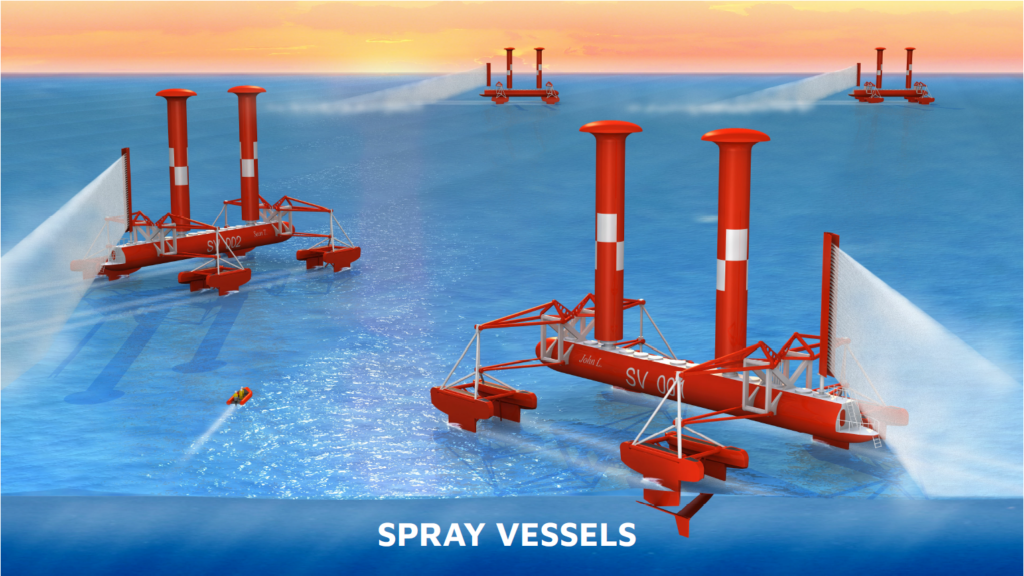
Concept Sketch
Marine Cloud Brightening deployment vessels proposed by Stephen Salter
1. Selected Videos about Marine Cloud Brightening
Saving the Arctic with Cloud Brightening
Marine Cloud Brightening – COP26 Presentation
-Why some clouds, such as cumulonimbus are dark, and some are light
– Using nozzles installed on ships to spray very small drops of filtered seawater 0.8 microns in diameter.
– Ships spraying filtered droplets of sea water could be deployed to reverse sea level rise and/or save the Arctic sea ice.
– Governments of countries could decide on targets for sea-surface temperatures – Cost estimates to deploy a fleet of 800 spray vessels/ships
– Advantages of MCB as a geoengineering technique to prevent the worst extremes of climate change
– How we can change the reflectivity of clouds in areas that will most benefit the Earth.
Should we reflect sunlight to cool the planet?
This video by Vox, addresses the controversy around solar radiation management as a climate mitigation method. The video conflates marine cloud brightening (MCB) with stratospheric aerosol injection (SAI) as if they are a single technology, nevertheless, some points are relevant to MCB, including the governance that would be required for large scale, international deployment.
However, the two SRM technologies are very different, with MCB having the advantage of being verstatile and agile, in terms of deployment and longevity of effect. As MCB works within the marine boundary layer (in the lower atmosphere) the individual clouds with the extra condensation nuclei (salt and minute water droplets) arising from deployment of a fleet of MCB spray vessels, would only last for a few days before the extra salt particles (cloud condensation nuclei) would fall out back down the sea when rain or drizzle occurs. By contrast, SAI would linger in the upper atmosphere for months. MCB can also be deployed at a local or regional level far more easily when and where required (for instance to cool the ocean surface in the warm ocean areas of the Atlantic where the most devastating hurricanes begin to form due to the heat).
2. Selected Scientific Papers
a) Papers About Marine Cloud Brightening
Twomey, S. 1974 Pollution and the planetary albedo. Atmos. Environ.
This ground-breaking research paper by Dr Sean Twomey first introduced the phenomenon that came to be known as the ‘Twomey Effect’ – the concept of enhanced cloud nuclei from anthropogenic pollution inadvertently increasing the amount of sunlight relected by clouds. Twomey was later awarded the Haagen-Smit Prize from the publisher of Atmospheric Environment, in recognition of this outstanding paper.
Latham, J., 1990 Control of global warming? Nature 347, 339–340
Salter, S Solar Radiation Management , Cloud Albedo Enhancement
Latham, J et al., 2012 Marine cloud brightening. Phil. Trans. Roy. Soc.
Salter, S. et al 2014, Engineering Ideas for Brighter Clouds, The Royal Society of Chemistry
b) Selection of Publications illustrating the Urgent Need for Marine Cloud Brightening R&D.
Substantial Radiative Warming by an Inadvertent Geoengineering Experiment from 2020 Fuel Regulations
This important research shows that the loss of the aerosol cooling effect from ship funnel emissions, due to WMO regulations making cleaner fuel compulsory since 2020, has had a deleterious effect on the climate by removing the cooling effect due to the sulfate aerosols accidentally created by the combustion of the old, dirtier fuel. This has inadvertently led to substantial warming of the ocean surface, effectively causing an increase in global warming. This lost cooling effect needs to be replaced somehow, preferably by a clean alternative, such as seawater based marine cloud brightening.
Hansen, J et al, 2023: Global Warming In the Pipeline, Oxford Open Climate Change, Volume 3, Issue 1
Hansen’s paper, based on strong paleoclimate data and recent empirical evidence and other observations, shows that the IPCC has underestimated the sensitivity of the climate to an increase in greenhouse gas levels. The research shows that carbon reductions and net zero are not able to lower the risk of catastrophic sea level rise and other disaterous effects of passing the 2C warming threshold before 2050.
The paper states ‘Reversing the trend is essential—we must cool the planet—for the sake of preserving shorelines and saving the world’s coastal cities.’ It goes on to specifically mention marine cloud brightening as one possible way of achieving this cooling: ‘Temporary solar radiation management (SRM) will probably be needed, e.g. via purposeful injection of atmospheric aerosols…The most innocuous aerosols may be fine salty droplets extracted from the ocean and sprayed into the air by autonomous sailboats.’
This paper discusses the serious issue of permafrost thaw. The permafrost covers nearly 23 million square kilometres and contains roughly double the amount of carbon currently in the atmosphere, much of it in the form of methane, as well as copious amount of nitrous oxide, another potent greenhouse gas. We should be looking at ways to slow down or reverse the thaw of the permafrost, using technologies such as marine cloud brightening.
Lenton, T et al, 2019 Climate tipping points — too risky to bet against (nature.com)
This research points out the risk of high impact, possibly catastrophic climate ‘tipping points’ being reached including loss of the Amazon Rainforest, is much higher than assumed by many scientists and politicians and demands urgent action to mitigate such risks.
Davariashtiyani, A. Taherkhani, M., Fattahpour, S. et al. Exponential increases in high-temperature extremes in North America. Sci Rep 13, 19177 (2023)
This paper shows that the rise in frequency and intensity of extreme weather events with continued global warming, in the absence of direct cooling interventions, is likely to accelerate dangerously as time goes on this century. This includes extreme heat events, which may ‘affect the health and resiliency of social, biological, and infrastructure systems in many regions worldwide’.

